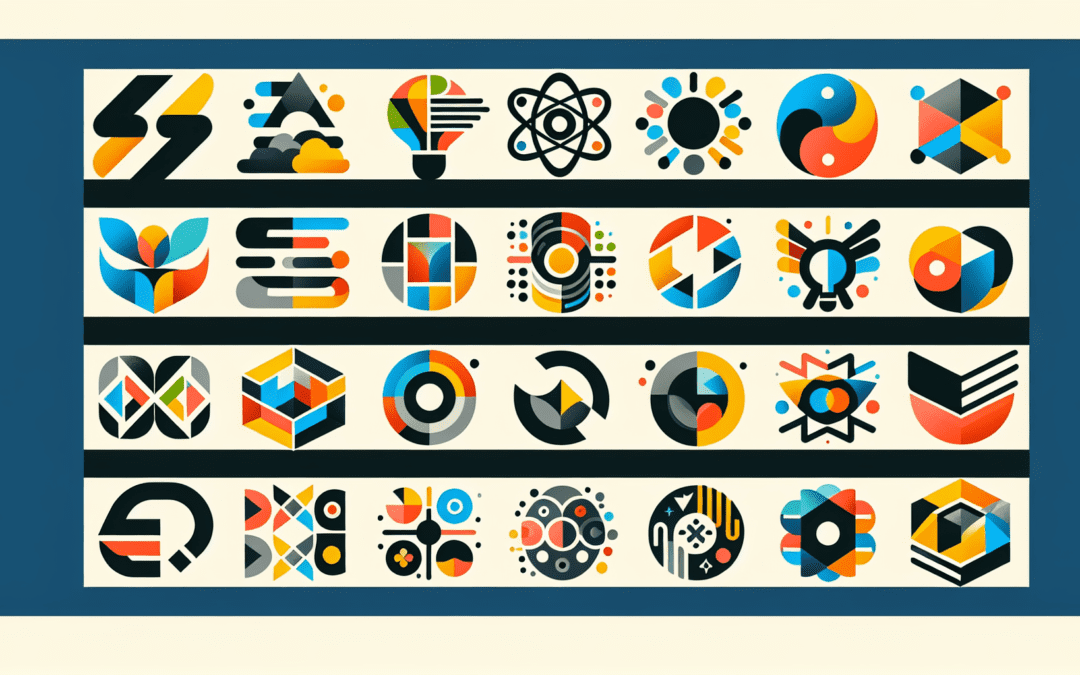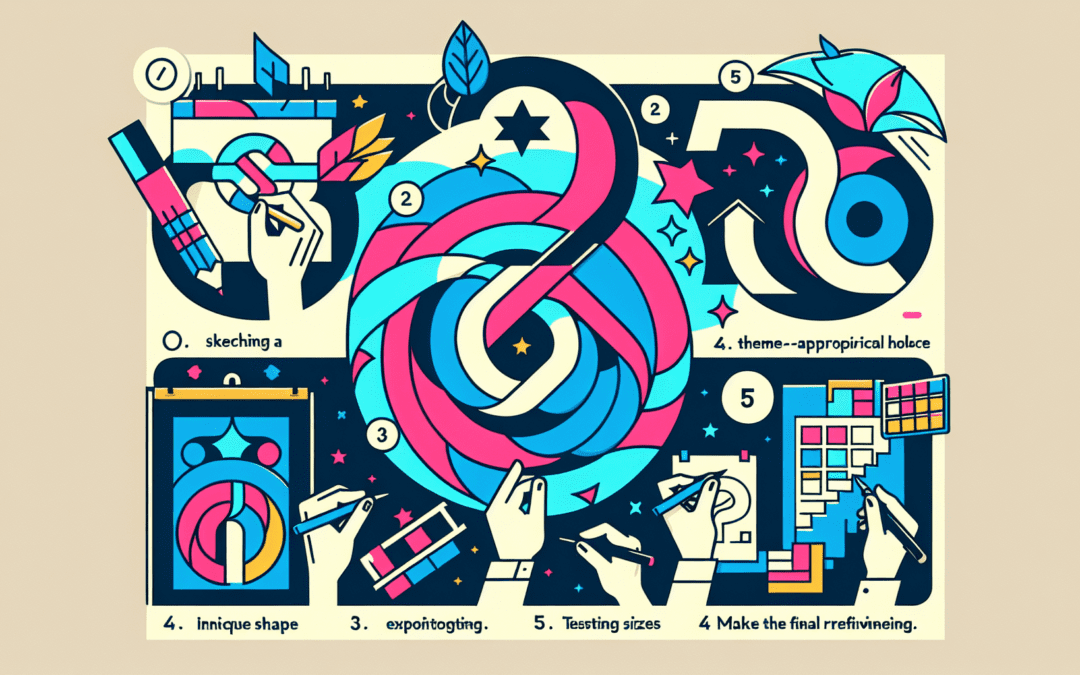
by chucho aguirre | Dec 21, 2023 | Branding, Startups
Why You Should Consider Hiring a Graphic Designer for Your Logo
When you’re thinking about starting a business or giving your current one a new look, one of the first things you might consider is getting a new logo. The logo is like the face of your business; it’s what people remember and recognize. It’s tempting to try and make one yourself or ask a friend to do it if they’re a bit artsy. However, hiring a professional graphic designer could be a much better choice. Here’s why.
Graphic designers are trained to create visuals that catch people’s eyes. They’ve spent a lot of time learning about colors, fonts, and shapes, and how these elements can tell a story or convey a message. They know what works and what doesn’t. Designing logos isn’t just about making something that looks cool; it’s about making something that represents your business perfectly. Graphic designers can take your ideas and bring them to life in a way that you might not have thought possible.
Save Time and Effort
Designing a good logo takes a lot of time and effort. There’s a lot more to it than just sketching a few drafts. You have to research, create multiple versions, get feedback, and make adjustments. If you’re running a business, your time is precious, and there are probably a hundred other things that need your attention. By hiring a graphic designer, you free up your time so you can focus on other important aspects of your business while someone else takes care of creating the perfect logo.
Stand Out from the Competition
A unique and professionally designed logo can make your business stand out from the competition. In a world where consumers are bombarded with hundreds of visuals every day, having a memorable logo is crucial. A graphic designer can help you create a logo that’s not only distinctive but also memorable and reflective of what your business stands for.
Future Use and Consistency
Once you have a logo, you’ll want to use it on everything associated with your business, from your website to business cards, to packaging. A graphic designer can provide you with different versions of your logo (like a black and white version, or a smaller size) and guide you on how to use them properly. This ensures that your brand looks consistent across all platforms, which is essential for building trust with your customers.
How to Hire a Graphic Designer
Now that you know the benefits of hiring a graphic designer, you might be wondering how to find one. Start by looking at portfolios online to see whose style matches what you’re looking for. Websites like Behance or Dribbble are great places to start. You can also ask for recommendations from other business owners. Once you find a designer you like, reach out to them with your project details and ask for a quote. Remember, the cheapest option might not always be the best. It’s worth investing in a high-quality logo that will serve your business well for years to come.
Hiring a graphic designer for your logo creation might seem like a big step, especially for small businesses or startups. But the benefits – a professional looking logo that appeals to your target audience, saves you time, and helps you stand out from the competition – make it an investment worth considering.

by chucho aguirre | Dec 5, 2023 | Branding, Corporate, Startups, Strategy
Having a unique and memorable logo is like giving your business a special key that unlocks the door to success. A well-designed logo can tell your story, make your brand stand out, and leave a lasting impression on customers. Here, we share some creative logo design ideas to help inspire your business’s distinctive symbol.
1. Use Negative Space
Negative space is the area around and between the elements of your logo. It’s like a hidden picture within a picture. This technique can make your logo super interesting and memorable. Think about the FedEx logo and its hidden arrow. Creating a clever use of negative space can surprise and delight people who see it.
2. Incorporate Your Product or Service
Another creative idea is to design your logo to include an element of what your business does. For instance, if you sell bicycles, you might include a bike wheel in your logo. Or, if you own a bakery, maybe a bread or pastry icon subtly included in your design will speak volumes. This can make your logo self-explanatory and instantly recognizable.
3. Use Handwriting or Custom Typography
Consider using handwriting or custom fonts in your logo. This approach can give your brand a unique voice and make it stand out from the crowd. Whether you choose a more elegant script or a simple, bold typeface, custom typography ensures that your logo is one of a kind. Just make sure it’s easy to read and reflects your business’s personality.
4. Go for Simplicity
Sometimes, less is more. Simple logos are often the most memorable and timeless. They’re easy to recognize and versatile, working well on everything from business cards to billboards. Think about the Apple logo or the Nike swoosh. Both are simple but incredibly effective at conveying their brand’s identity.
5. Play With Colors
Colors can evoke emotions and communicate messages. For example, blue can convey trust and reliability, while green often represents growth or eco-friendliness. Choose colors that reflect your business’s values and ensure they stand out. But remember, your logo should also look good in black and white, especially for certain uses, like in newspapers.
6. Get Inspired by Nature
Nature can be a great source of inspiration for logo designs. Animals, plants, mountains, or water can symbolize various qualities like strength, growth, or calmness. A tree, for instance, could represent growth and stability. Drawing inspiration from nature can lead to a beautiful and meaningful logo.
7. Be Bold and Experiment
Last but not least, don’t be afraid to experiment. Try different combinations of symbols, fonts, and colors. Sometimes, the most unconventional ideas could turn into the most brilliant logos. Think outside the box and create something truly unique.
Designing a logo is a creative journey that requires thought, research, and plenty of sketching. Remember, the goal of your logo is to tell your brand’s story at a glance, make a great first impression, and set the stage for all of your future branding efforts. With these creative ideas, you might just find the perfect design that represents your business perfectly.

by chucho aguirre | Nov 6, 2023 | Branding, Startups, Strategy
5 Steps to Design Your Perfect Logo
Creating a logo that epitomizes your brand’s identity and core values may seem like a daunting task. However, with a structured approach, the journey from concept to final design can be both creative and enjoyable. Below are five crucial steps to help you design a logo that not only stands out but also encapsulates everything your brand stands for.
1. Understand Your Brand and Audience
Before embarking on the design process, it’s pivotal to have a deep understanding of your brand’s essence and the audience you intend to reach. Your logo should reflect your brand’s personality, whether it’s professional, creative, playful, or sophisticated. Consider what makes your brand unique and what feelings you want it to evoke in your audience. Imagining your brand as a person and thinking about how it would communicate helps set a solid foundation for your logo.
2. Conduct Market Research
Research is a critical step in avoiding clichés and ensuring your logo stands out in a crowded market. Study your competitors to see how they are visually communicating with their audience. Look for trends in your industry’s logo designs, but be wary of following them too closely. Your goal should be to differentiate your brand while staying relevant. This phase is also about drawing inspiration from the world around you, not just your direct competition.
3. Choose Your Design Style
Deciding on a design style early on can help streamline the logo creation process. This style should align with your brand’s identity and the message you want to convey. There are several directions to consider, including classic, modern, whimsical, or handcrafted. Keep in mind the versatility of your logo; it should look good on various platforms, from your website to social media to print materials.
4. Play with Colors and Typography
Colors and typography play a significant role in how your logo is perceived. Each color invokes different emotions and associations, so choose ones that align with your brand’s personality. When it comes to typography, the choice of font should complement the logo’s style and be legible across all sizes. Experiment with different font and color combinations until you find the perfect match. Remember, simplicity often leads to a more timeless and versatile logo.
5. Test and Refine Your Logo
Once you have a design in mind, it’s important to test your logo in various scenarios to ensure it functions well across different mediums and contexts. This might include seeing how it looks on business cards, websites, or merchandise. Gather feedback from a diverse group of people, including potential customers, to see how your logo is received. Use this feedback to refine your design further. Remember, a great logo is not just about looking good; it’s about effectively communicating your brand’s identity.
Creating the perfect logo for your brand is a journey that requires thought, research, creativity, and refinement. By following these steps, you’re more likely to end up with a logo that not only looks professional but also deeply resonates with your target audience and stands the test of time.

by Saïd | Oct 18, 2023 | Branding, Startups, Strategy
Understanding the basics of startup strategy
Startup strategy is crucial for the success of socially conscious entrepreneurs in Washington, DC. Here are some essential tips to keep in mind when developing your startup strategy:
Identify your target market and understand their needs and preferences.
Create a unique value proposition that sets your business apart from competitors.
Develop a clear and realistic business plan that outlines your goals and objectives.
Focus on building a strong brand identity that resonates with your target audience.
Stay adaptable and be willing to iterate your strategy based on market trends and customer feedback.

Identifying your target market and niche
To identify your target market and niche, start by researching and analyzing your potential customers. Understand their needs and preferences to tailor your products or services accordingly. You can also conduct surveys or interviews to gather valuable insights. Once you have a clear understanding of your target market, focus on finding a niche within your industry. Differentiate your business by offering unique value propositions that resonate with your target audience. This will help you stand out in the market and attract the right customers for your socially conscious startup.
Integrating social responsibility into your business model
Being a socially conscious entrepreneur means integrating social responsibility into your business model. Here are five essential startup strategy tips to help you in Washington, DC:
-
Understand the Local Community Needs: Before deciding on your social initiatives, get to know the specific needs of the local community in Washington, DC.
-
Find the Right Partners: Collaborate with local non-profits and organizations to amplify the impact of your social initiatives.
-
Embrace Transparency: Communicate openly about your social responsibility efforts with your customers and stakeholders.
-
Create Measurable Goals: Set clear and measurable social impact goals to track your progress and hold yourself accountable.
-
Make a Long-Term Commitment: Social responsibility shouldn’t be a one-time effort. Integrate it into your business model for the long haul.
Leveraging local resources and support networks
When starting a socially conscious business in Washington, DC, it’s essential to leverage local resources and support networks. Here are some tips to help you make the most of what’s available:
-
Connect with local business organizations: Joining groups like the DC Chamber of Commerce or the Small Business Development Center can provide you with valuable networking opportunities and resources to help grow your startup.
-
Utilize local incubators and accelerators: Take advantage of programs like 1776 or Impact Hub DC, which offer support, mentorship, and access to potential investors.
-
Tap into government resources: Washington, DC offers various programs and grants to support small businesses, especially those with a social impact mission. Explore options like the DC Department of Small and Local Business Development for potential assistance.
-
Network with other socially conscious entrepreneurs: Building relationships with like-minded individuals can provide you with guidance, inspiration, and potential collaboration opportunities.
-
Engage with the local community: Establishing a strong presence within the community can help generate local support and clientele. Consider partnerships with local non-profits or participating in community events to raise awareness about your socially conscious business.
Navigating legal and regulatory considerations in Washington, DC
When starting a socially conscious business in Washington, D.C., it’s crucial to understand the legal and regulatory requirements. Here are some essential tips to help you navigate this aspect:
-
Research and understand the specific legal and regulatory requirements for your industry in Washington, D.C.
-
Consider consulting with a local attorney who specializes in business law to ensure compliance with local regulations.
-
Be aware of any permits or licenses that may be required for your business operations in the district.
-
Stay informed about any changes in the legal landscape that may affect your business, such as new ordinances or regulations.
-
Establish good relationships with local government officials and regulatory agencies to gain insights into any upcoming changes or requirements that may impact your business.






Recent Comments